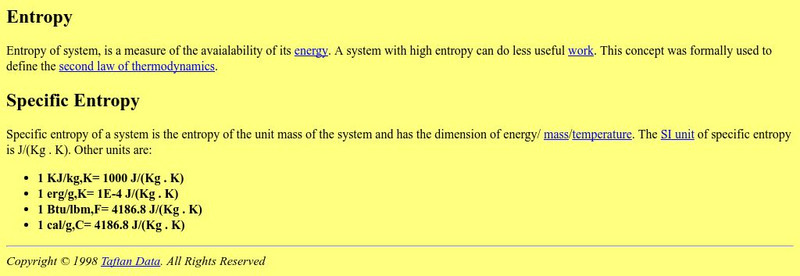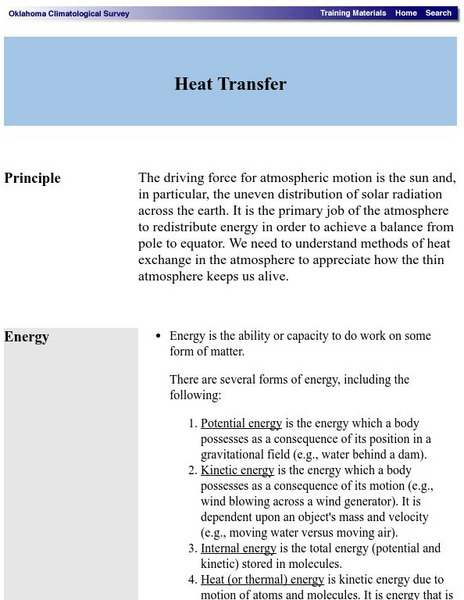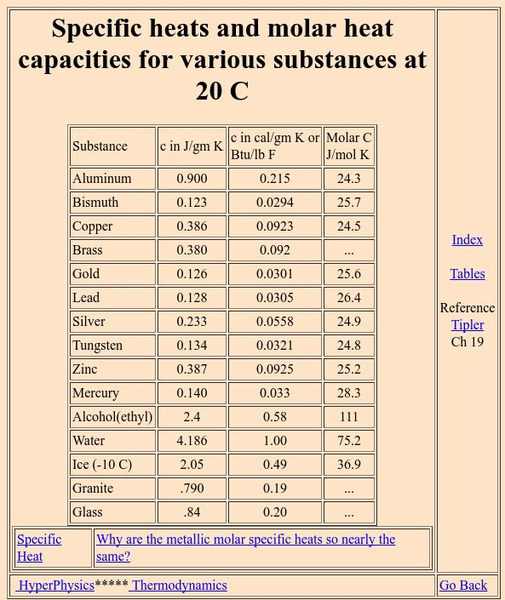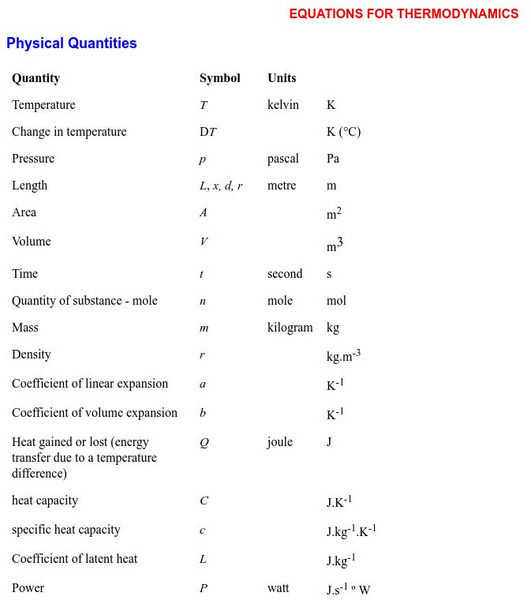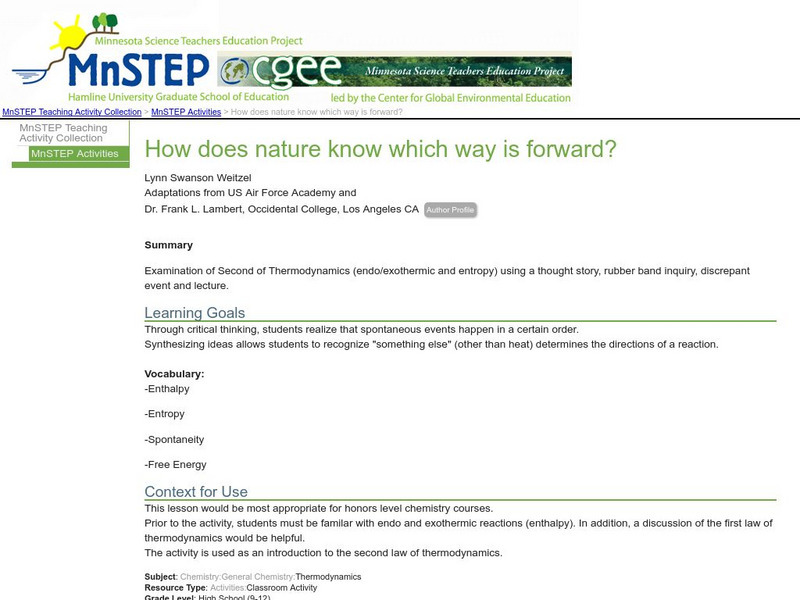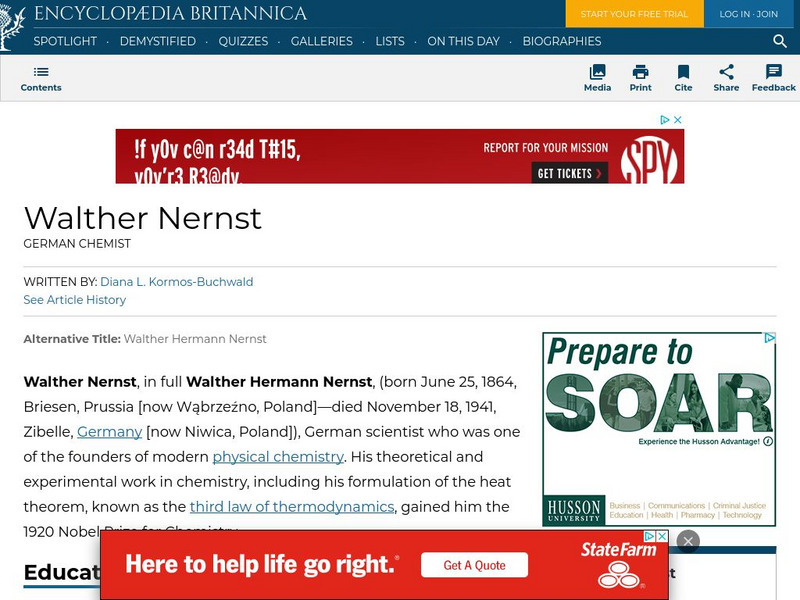Hi, what do you want to do?
Science Struck
Science Struck: Conduction, Convection, and Radiation
Explains the concept of heat transfer and describes conduction, convection, and radiation which are the three modes of heat transfer. Includes formulas, examples, and applications.
Other
Applied Thermodynamics: Entropy
Entropy is defined and discussed at this site from Applied Thermodynamics. The equation for this mathematical quantity is given and explained. Some unit information concerning entropy is provided.
TED Talks
Ted: Ted Ed: Why Don't Perpetual Motion Machines Ever Work?
Netta Schramm describes the pitfalls of perpetual motion machines.
Concord Consortium
Concord Consortium: Molecular Workbench: Loschmidt's Paradox
Use this simulation to observe how Loschmidt's Paradox affects the entropy of an isolated system.
Khan Academy
Khan Academy: What Is the Ideal Gas Law?
Learn how pressure, volume, temperature, and the amount of a gas are related to each other.
FT Exploring
Ft Exploring: Energy, Heat Flow, and Life
Here you can learn all about heat flow, one of the major driving forces of nature, and how it works. It is the force behind weather, photosynthesis, animal behavior, and much more.
Physics Classroom
The Physics Classroom: Thermal Physics: What Is Heat?
This physics tutorial is devoted to understanding how the relative temperature of two objects affects the direction that heat is transferred between the two objects.
Oklahoma Mesonet
Oklahoma Climatological Survey: Heat Transfer
A discussion from the Oklahoma Climatological Survey of the thermal factors effecting the movement of air masses in the atmosphere. Numerous topics such as methods of heat transfer, latent heat, phase changes (including sublimation and...
Walter Fendt
Walter Fendt: Apps Zur Physik
This site, in German, offers numerous apps that illustrate common physics principles. Apps are organized into categories: mechanics, oscillations and waves, electrodynamics, optics, thermodynamics, the theory of relativity, physics of...
Georgia State University
Georgia State University: Hyper Physics: Specific Heats and Molar Heat Capacities
A lengthy listing of values for specific heats and molar heat capacities for a variety of substances at 20 C. An explanation is given for why molar heat capacities for metals are nearly the same.
Wikimedia
Wikipedia: The Black Hole
This site examines the black hole as an object in astrophysics. Delve into this comprehensive resource that covers this concept from its history, to qualitative physics, the reality of black holes, mathematical physics and more.
NASA
Nasa: From Stargazers to Starships: Energy
Demonstrates how principles of kinetic energy, potential energy and energy conservation can be used to determine the speed of a descending object if given its initial height. Further discussion of other topics such as heat and...
Museum of Science
The Atoms Family
Let this classic family of monsters guide you as you learn about energy. Interactive exercises, experiments, and demonstrations help to build knowledge and raise questions.
University of Sydney (Australia)
Equations for Thermodynamics
An exhaustive list of equations and formulas which are commonly used in thermal physics (including equations for triple point). Equations are organized according to category. Meaning of the symbols is clearly stated.
Cosmo Learning
Cosmo Learning: Physics 240: Science and Engineering I
A collection of video lectures from a physics for science and engineering course taught at the University of Missouri-Kansas City. The course discusses the concepts of mechanics, wave motion, sound, heat and thermodynamics in thirty-five...
Texas Instruments
Texas Instruments: Solar Cookers and Easy Data
Students use a TI-84, Easy Temp and Easy Data to measure the quality of solar cookers. Hot dogs are heated under the May sunshine after students design, build and test their own solar cookers.
Science Education Resource Center at Carleton College
Serc: Popping Up Some Fun!
In this hands-on activity, students will investigate the properties of popcorn and discover what makes popcorn pop. They will compare popped and unpopped corn and hypothesize about why popcorn pops, discovering that popcorn pops because...
Other
Perpetual Motion Page: Machines
This personal site provides a good selection of proposed perpetual motion machines complete with drawings and detailed explanations of the machines.
Texas Education Agency
Texas Gateway: Temperature
Read and view examples and formulas about temperature, its measurement by thermometers, and its relationship to thermal equilibrium.
Khan Academy
Khan Academy: What Are Pv Diagrams?
Learn what PV diagrams are and how to use them to find the change in internal energy, work done, and heat.
Science Education Resource Center at Carleton College
Serc: How Does Nature Know Which Way Is Forward?
Through critical thinking, students realize that spontaneous events happen in a certain order. This lesson plan presents an examination of the Second Law of Thermodynamics using a thought story, rubber band inquiry, discrepant event and...
Encyclopedia Britannica
Encyclopedia Britannica: Walther Nernst
This site from Britannica Guide to the Nobel Prizes provides a good overview of Walther's (1864-1941 CE) life, focusing exclusively on his scientific endeavours.
Simon Fraser University
Chem1 Virtual Textbook: The Equilibrium Constant
With an overview of topics related to chemical equilibrium, this site provides a foundation to a study of thermodynamics and equilibrium. Included in the discussion with the equilibrium constant are topics such as equilibrium and...
Other
Applied Thermodynamics: Heat Transfer
Heat transfer, rates of heat exchange,conduction, radiation and convection are defined and discussed at this site from Applied Thermodynamics. Well illustrated.
Other popular searches
- Second Law of Thermodynamics
- First Law of Thermodynamics
- 1st Law of Thermodynamics
- 2nd Law of Thermodynamics






